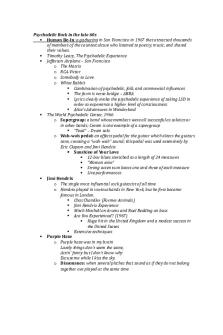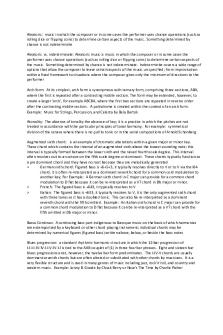Music Appreciation Exam 1 vocab pdf PDF

| Title | Music Appreciation Exam 1 vocab pdf |
|---|---|
| Author | Leah Quam |
| Course | Music Appreciation |
| Institution | Kirkwood Community College |
| Pages | 4 |
| File Size | 54.3 KB |
| File Type | |
| Total Downloads | 38 |
| Total Views | 151 |
Summary
Exam 1 review vocabulary...
Description
Music Appreciation Vocabulary Exam 1 Review *Melody: Succession of single pitches perceived by the ear as a unity. -Contour: Overall shape of a melodic line it can move up or down or remain constant. -Range: Distance between lowest and highest pitches of a melody, instrument or voice. *Interval: Distance and relationships between two pitches. -Conjunct: Smooth, connected melody that moves principally by small intervals. -Disjunct: Disjointed or disconnected melody with many leaps. *Phrase: Musical unit, component of a melody. -Cadence: Resting place in a musical phrase, a musical punctuation. *Rhythm: Controlled movement in time. *Meter: Organization of rhythm in time grouping of beats into larger, regular patterns, notated as measures. -Beat: Regular pulsation, basic unit of length in musical time. *Harmony: Simultaneous combination of notes and ensuing relationships of intervals and chords. *Chords: Simultaneous combination of 3 or more pitches that constitute of a single block of harmony. *Major/Minor: A harmonic system based on the use of major and minor scales, widely practiced from the 17th to the late 19th century. *Dissonance: Combinations of tones that sound discordant and unstable, in need of resolution.
VOCAL
!1
*Consonance: Concordant or harmonius combination of pitches that provides a sense of relaxation and stability in music. *Texture: The interweaving of melodic (horizontal) and harmonical (vertical) elements in musical fabric. -Monophony: Single line, texture or melody without accompaniment. -Polyphony: Two or more melodic lines combined into a multi-voiced texture, as distinct from monophase. -Homophony: Texture with a principle melody and accompanying harmony, as distinct from monophase. *Imitation: Melodic idea presented in one voice or part, then restated in another, each part continuing as others enter. *Form: Structure and design in music, based on repetition, contrast, and variation the organizing principle of music. -Strophic: Song structure in which the same music is repeated with every stanza of the poem. -Through composed: Song structure that is composed from beginning to end, without repetitions of large sections. -Binary (A-B): Two part (A-B) form with each section normally repeated. Two part form. -Ternary (A-B-A): Three part (A-B-A) form based on a statement (A), contrast (B), and repetition (A). *Theme: Melodic used as a building block in the construction of a piece. *Tempo: Rate of speed or pace of music. -Gravo: Solumn, very very slow. -Largo: Broad, very slow
VOCAL
!2
-Adagio: Quite slow. -Adante: Moderately slow, walking pace. -Moderato: Moderate. -Allegro: Fast, cheerful. -Vivace: Lively -Presto: Very fast. - Accelerando: Getting faster - Ritardando: Getting slower - a Tempo: Return to previous tempo *Dynamics: Element of musical expression relating to the degree of loudness or softness, volume. -Pp: Pianissimo, very soft -p: Piano, soft -mp: Mezzo piano, moderately soft -mf: Mezzo forte, moderately loud -f: Forte, loud -ff: Fortissimo, very loud -Crescendo: Growing louder -Dimuendo: Growing softness *Secular music: Nonreligious, when there is text, it is usually vernacular. -Vernacular: Common language spoken by the people as distinguished from the literary language or language of educated elite. *Sacred music: Religious or spiritual music, church or devotional use. *Syllabic text setting: Melodic style with one note set to each text syllable.
VOCAL
!3
*Neumatic text setting: Melodic style with 2 to 4 notes set to each syllable. *Melismatic text setting: Melodic style characterized by many notes sung to a single text syllable. *Word painting: Musical pictorilization of words as an expressive device, a prominent feature of a Renaissance madrigal.
VOCAL
!4...
Similar Free PDFs

Music Appreciation
- 1 Pages

Music Appreciation test 2
- 8 Pages

Music Appreciation Notes
- 2 Pages

Music Appreciation Final Essay
- 3 Pages

Music Appreciation Notes Feb. 25
- 2 Pages

Music Appreciation Notes Feb. 9
- 2 Pages

Music Copyright Law - Exam 1
- 10 Pages

Final Exam Vocab
- 8 Pages

397375933 Music Theory Terms pdf
- 12 Pages
Popular Institutions
- Tinajero National High School - Annex
- Politeknik Caltex Riau
- Yokohama City University
- SGT University
- University of Al-Qadisiyah
- Divine Word College of Vigan
- Techniek College Rotterdam
- Universidade de Santiago
- Universiti Teknologi MARA Cawangan Johor Kampus Pasir Gudang
- Poltekkes Kemenkes Yogyakarta
- Baguio City National High School
- Colegio san marcos
- preparatoria uno
- Centro de Bachillerato Tecnológico Industrial y de Servicios No. 107
- Dalian Maritime University
- Quang Trung Secondary School
- Colegio Tecnológico en Informática
- Corporación Regional de Educación Superior
- Grupo CEDVA
- Dar Al Uloom University
- Centro de Estudios Preuniversitarios de la Universidad Nacional de Ingeniería
- 上智大学
- Aakash International School, Nuna Majara
- San Felipe Neri Catholic School
- Kang Chiao International School - New Taipei City
- Misamis Occidental National High School
- Institución Educativa Escuela Normal Juan Ladrilleros
- Kolehiyo ng Pantukan
- Batanes State College
- Instituto Continental
- Sekolah Menengah Kejuruan Kesehatan Kaltara (Tarakan)
- Colegio de La Inmaculada Concepcion - Cebu






